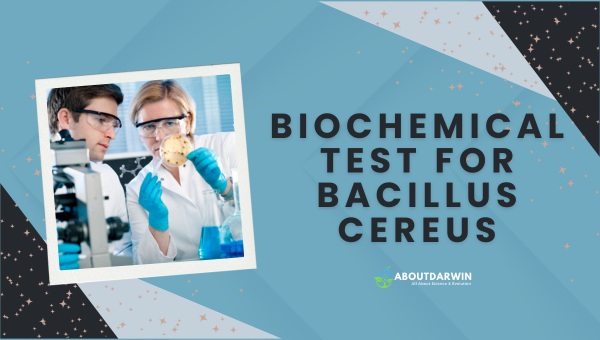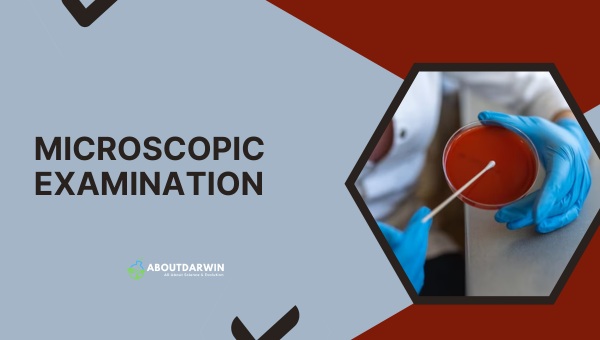Physical Address
304 North Cardinal St.
Dorchester Center, MA 02124
If you’re like most people, you probably don’t give much thought to the microscopic world around and even inside us – a world teeming with all sorts of bacteria, some harmful and others not. Among them is Bacillus cereus, a sneaky little bacterium that might just be lurking in your favorite dish.
Bacillus cereus is one of those organisms that deserves attention, especially because of its connection to foodborne illnesses. Its ubiquity – found in soil, vegetables, and a variety of processed foods – plus its potential to cause harm makes it critical for us to understand how we can identify this bacteria through biochemical testing.
But before we delve into the details of how these tests work, let me give you a quick primer on the basic principles and properties of Bacillus cereus.
Contents
| Basic Characteristics | Properties (Bacillus cereus) |
|---|---|
| Catalase | Positive (+ve) |
| Gelatin Hydrolysis | Negative (-ve) |
| Gram Staining | Positive (+ve) |
| Hemolysis | Positive (+ve) |
| Growth in KCN | Positive (+ve) |
| Citrate | Positive (+ve) |
| Indole | Negative (-ve) |
| Motility | Positive (+ve) |
| Nitrate Reduction | Variable |
| MR (Methyl Red) | Negative (-ve) |
| Oxidase | Negative (-ve) |
| VP (Voges Proskauer) | Positive (+ve) |
| Pigment | Negative (-ve) |
| Shape | Rods |
| Spore | Positive (+ve) |
| Gelatin Hydrolysis | Negative (-ve) |
| MR (Methyl Red) | Negative (-ve) |
| Nitrate Reduction | Variable |
| VP (Voges Proskauer) | Positive (+ve) |
Bacillus cereus is a gram-positive, rod-shaped bacterium that is notoriously known for its role in foodborne illnesses. These bacteria, typically found in soil and vegetation, can survive harsh conditions because of their ability to form spores.
This allows them to easily contaminate a wide range of foods, leading to food safety concerns as they can produce harmful toxins when ingested.
From a health perspective, Bacillus cereus can impact humans with two types of illnesses – emetic syndrome, characterized by nausea and vomiting, and diarrheal syndrome, which affects the digestive system. Hence, their detection and elimination from food supplies is crucial for maintaining public health safety standards.
Also Read: Mastering Polymerase Chain Reaction: Principle & Application
Biochemical testing for Bacillus cereus is an essential process used to confirm its presence in various food samples.

These tests, performed in labs, delve into the biochemical activities of this bacteria, helping identify its distinctive traits and properties for accurate detection.
When I encounter the task of identifying Bacillus cereus, a powerful tool at my disposal is microscopic examination. These bacteria carry some distinct characteristics that catch your eye upon close inspection.

Under a microscope, Bacillus cereus appears as large rectangular rods, usually arranged in pairs or short chains. This organism is Gram-positive, which means it holds onto a purple dye used in the standard Gram stain procedure.
Another key feature that pops under the microscope is their ability to form spores – hardy structures rendering them resistant to heat and disinfection strategies.
The spores of Bacillus cereus are central and unswollen, meaning we can see them resting right in the middle of bacterial cells without causing any noticeable distension. With this knowledge and keen observation skills, a microscopic examination affords us an initial glance at suspect bacilli.
Now, moving on to more advanced identification techniques – understand one thing clearly: while traditional methods hold their importance in bacterial identification, rapid technological advancements have indeed revolutionized this field. Today, we use tools like Polymerase Chain Reaction (PCR) for precise identification of bacteria down to the species level.
For Bacillus cereus specifically, PCR can be indispensable! By amplifying target DNA sequences that are unique only to Bacillus cereus (for instance – sequences coding for its specific toxin genes), PCR helps us confirm suspected cases with high accuracy even when there are closely related Bacilli present within the sample!
For these reasons, molecular techniques like PCR have become go-to strategies for swift and accurate detection essential for managing potential outbreaks effectively!
Also Read: Enterobacter Cloacae: Understanding the Biochemical Test
When addressing concerns related to contamination and food safety, B. cereus – or Bacillus cereus – often requires special attention. As a type of bacteria capable of causing food poisoning, preventive measures in the food industry are necessary to ensure consumer safety.
Below, we’ve highlighted several strategies that can help minimize the risks associated with this particular pathogen.
Ensuring the safety and quality of food products is paramount in the food industry. From farm to table, adopting a culture of best practices is key to maintaining consumer trust and compliance with health standards.
It’s not just about following rules; it’s about setting a standard of excellence that safeguards public health.
Recent concerns surrounding food safety have brought attention to the prevalence and risks of Bacillus cereus in the food industry. As a bacterium that thrives in various environments, B. cereus can contaminate a wide array of food products, leading to potential health hazards if not properly managed.
In response to these challenges, we are focusing on identifying key strategies and protocols to mitigate the risks associated with this microorganism.
Bacillus Cereus best thrives in warm, moist environments. It can multiply quickly in temperatures ranging from 10-50 degrees Celsius.
The identification and control of B. cereus reduces foodborne illnesses due to its capability to produce harmful toxins when ingested.
Yes, in addition to the mentioned tests, others like starch hydrolysis tests and motility tests are also conducted for the detection of B. cereus.
Bacillus cereus itself may be killed by thorough heating. Still, their spores can withstand high temperatures, indicating that proper cooking alone might not eliminate the risk of foodstuffs contaminated with this bacteria’s spores.
Also Read: Distinguishing between Anthrax Bacilli and Anthracoid Bacilli
Bacillus cereus is not something to ignore. It’s a common bacterium that can grow in a multitude of environments, posing significant threats to food safety and human health. From tainting our food supplies with its toxins to causing illnesses like diarrhea and vomiting, this pesky bacterium can spell trouble if left unchecked.
The significance of conducting reliable biochemical tests for its identification should never be underestimated. Accurate and swift identification of this bacterium paves the way for implementing appropriate control measures and treatments, ensuring our food remains safe to consume. To put it simply – knowing your enemy is half the battle won!